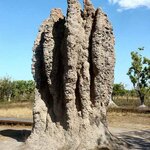Ecology & Zoology

Despite the fact that most of us see our four-legged friends walking around every day, most people (including many experts in natural history museums and illustrators for veterinary anatomy text books) apparently still don't know how they do it.
A new study in Current Biology shows that anatomists, taxidermists, and toy designers get the walking gait of horses and other quadruped animals wrong about half the time, despite the fact that their correct walking behavior was described and published more than 120 years ago.
So, then, how do they walk? It turns out that all four-legged animals…

The cathedral termite, found in parts of Australia, is capable of creating mounds for the colony well over 10 feet high. Individual cathedral termites are just standard-looking bugs - head, thorax, abdomen, legs, and so on, with a tiny little primitive brain. But when combined with others of its species, the cathedral termite is capable of constructing a huge, complex hive to house the colony. Unlike human building projects, however, there is no foreman, no plan, and it's unlikely that any termite even knows what it is helping to create.
How is this possible?
The answer lies in the fact that…

Living with a female mouse can extend the reproductive life of a male mouse by as much as 20 percent, according to a study conducted by Ralph Brinster and a team of other researchers at the University of Pennsylvania School of Veterinary Medicine and reported in the journal Biology of Reproduction.
They say this significant implications for the maintenance of male fertility in wildlife and even human populations.
The researchers hypothesize that the females' effect on the environment of the spermatogonial stem cells likely occurs through the male's endocrine and nervous systems,…

My elementary school art teacher used to discourage the use of rulers, claiming that “there are no straight lines in nature”. Mr. Dugan, your own cells are here to tell you it’s not true. Systems of taut fibers and light struts— as straight as the bars and chains of a swingset—are omnipresent in biological forms.
These organic analogs to popsicle sticks and rubber bands often occur in interwoven networks reminiscent of the geodesic domes that Buckminster Fuller promoted in the 1950’s. Since form follows function, it’s hardly surprising that these natural geodesics offer the…

Mutants are always interesting, right? (With the exception of sequels?) Anyways, today's mutant offering is two-headed fish in Australia. (First cane toads, now this? Can't the Aussies get a break?)The current hypothesis is that the two-headed, four-eyed critters have been horribly misshapen due to....macadamia nuts? According to Discover.com (the article is worth a read just for the phrase, "Lando sent a report...", if you're a Star Wars nut like me), "noxious fumes" from a macadamia nut farm may be contaminating the water in the Noosa River.
Ah, but if you read…

5.
That's how many mated pairs will need to have survived the extensive habitat loss that occurred during the early 1900's for the ivory-billed woodpecker to still be around today.
Do they exist? No one knows, though in the last few years people have claimed to see them. But people have claimed to see Bigfoot too.
Crow-sized and native to America's ancient southeastern bottomland forests, the ivory-billed woodpecker was thought to have gone extinct following indiscriminate logging in the 1940s until reports began surfacing in the flooded forests of eastern Arkansas in 2004.…

The ecology is a dynamic, complex system so even small changes, or small experiments, can have big responses. Some of these responses, including insect outbreaks, wildfire, and forest dieback, may adversely affect people as well as ecosystems and their plants and animals.
The U.S. Geological Survey led a new assessment of the implications of a warming world on "ecological thresholds" in North America. The report, which was commissioned by the U.S. Climate Change Science Program and authored by a team of federal and academic climate scientists, is based on a synthesis of published…

Free-range chickens are more prone to disease than chickens kept in cages, according to a study published in Acta Veterinaria Scandinavica. This also applies to all chickens kept in litter-based housing systems.
Researchers led by Oddvar Fossum, at the National Veterinary Institute in Sweden, noted that during the switch in housing from battery cages to enriched cages and litter-based systems, including free-range, there was an increase in the number of chickens dying. During the study, the authors compared the causes of deaths in flocks of chickens kept in different types of housing…

The term 'invasive species' itself connotes very bad things but conservationists recently got an expensive lesson in the one thing they claim to understand; ecology is a system and making too many changes can have devastating repercussions.
Removing an invasive species from sub-Antarctic Macquarie Island, a World Heritage Site, has caused environmental devastation that will cost more than A$24 million to remedy, ecologists have revealed. Writing in the new issue of the British Ecological Society's Journal of Applied Ecology, they warn that conservation agencies worldwide must learn important…